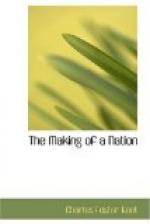In a community thus closely bound together the morality of each individual was guarded with a jealousy unknown in more settled prosperous communities. Thus, for example, adultery from the first appears to have been punished by public stoning. How far has this characteristic survived to the glory of the Jewish race?
The tribal organization also cherished the freedom of each individual. His voice was heard in its council and his rights were carefully protected. The free atmosphere of the desert tolerated no despotism, and the sheik was the servant of all. These fundamental conceptions of government persisted even when, under the influence of a new agricultural environment, the Hebrews established the kingship and monarchy. It was the struggle between these inherited democratic ideals and those of the neighbors who were ruled by despots, that ultimately disrupted the Hebrew kingdom and called forth those great champions of liberty and social justice, the prophets of the Assyrian period. It was this same democratic atmosphere that made possible the work of those prophets, who openly denounced the crimes of king and people. How far have the Jews throughout all their history allied themselves with democratic movements?
III.
THE INFLUENCE OF THE WILDERNESS LIFE UPON ISRAEL’S FAITH.
The pressure of constant danger intensified the sense of dependence upon a power outside and above themselves. It led them to look constantly to Jehovah as their sole guide and deliverer. A continued attitude crystallized into a habit. Hence, throughout their troubled career the Hebrews have been conscious of the presence of God and have found in him their defender and personal friend as has no other people in human history.
As later generations meditated on the perils of the wilderness through which their ancestors passed, they naturally felt that only under the immediate guidance of a divine power could they have escaped. They were familiar with the way in which the caravans travel through the desert: in front of the leader is borne aloft a brazier filled with coals. From this smouldering fire there arises by day a column of smoke that, in the clear air of the desert, can be easily seen afar by any who may straggle behind. At night these glowing coals seem like a pillar of fire, telling of the presence of their leader and protector. With the same vivid imagery, according to some interpreters, the later Hebrews pictured the march of their ancestors through the wilderness, and thereby symbolized the belief that Jehovah was then present and that through his prophet Moses he was personally guiding his people. How far have these Old Testament narratives been thus interpreted by modern western readers? Does it change their spiritual significance to seek to learn their origin and real literary character? Are there still to be found, often in humble walks of life, earnest




